Queen Wilhelmina’s Trousseau - 1901

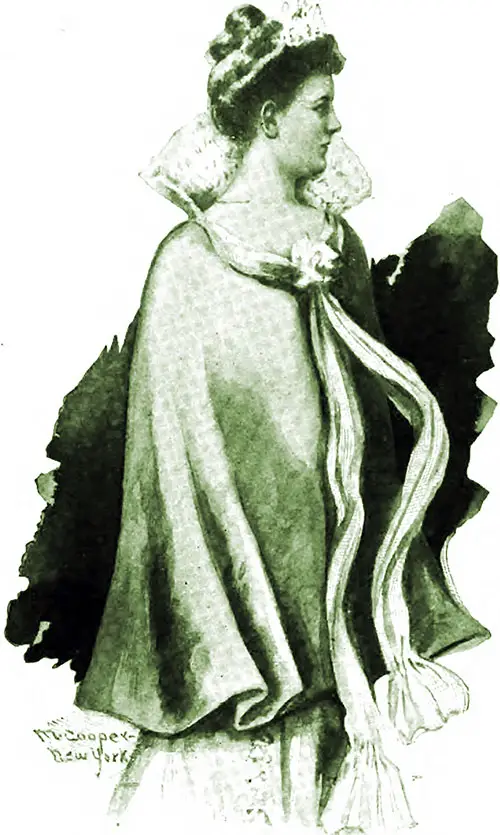
Queen Wilhelmina's Bridal Cape of Cloth of Silver With Chiffon Scarf. GGA Image ID # 15f9bc057a
THE HAGUE, February 25, 1901.
Few people outside of Paris, except country dressmakers and journalists, know what a “maison fermé’’ is in the dressmaking trade. Many journalists, representing papers from all over the world, have learned anew the full significance of the expression during the preparation of the Dutch Queen's trousseau in the Rue de Rivoli by Madame Nicaud.
A “maison fermé” is a shop where gowns are made in secret and where it is about as easy to interview a queen's dressmaker as it is to interview the queen herself.
Wilhelmina of Holland is very patriotic, and she wanted to conceal from her people the fact that she had resorted to Paris for her gowns. Thus, in making this royal trousseau, the precautions for secrecy were doubled, thus it happens that every other Hollander you may meet will declare that each garment was made in the fatherland, and thus it has happened that journalists have implored of Madame and unscrupulous ones have offered bribes to the workmen, but all in vain.
Some of the defeated journalists have excellent imaginations and many talents in designing gowns. They went home and wrote columns about the trousseau; they drew wedding gowns for the Queen which would have done credit to Madame Nicaud herself!
Through a “friend at court," I was given the privilege of seeing some of the gowns, and this design of the wedding gown was made as it rested on the form of a model for the last critical judgment. It was as glistening, shimmering, and stately a bridal dress as any royal bride would want. The skirt had a wide front of tulle from the same piece as the wedding veil, and as the tulle fell in soft folds to the bottom, it showed an exquisite embroidery of orange blossoms just below the knees and in four perpendicular lines to the hem.
The foundation of cloth of silver gleamed through the tulle, but it came forth unveiled in the rest of the skirt. A wide embroidery of orange blossoms outlined the side pieces, coming from the waist to the bottom, up again and around the V-shaped panels of tulle set in the cloth at the bottom. Then the embroidery was continued clear around the court train, three yards long. It was worked in brilliants and pearls for the petals, with the leaves of real silver thread. The National School of Applied Arts at The Hague embroidered the gown, and it took many busy fingers many busy weeks.
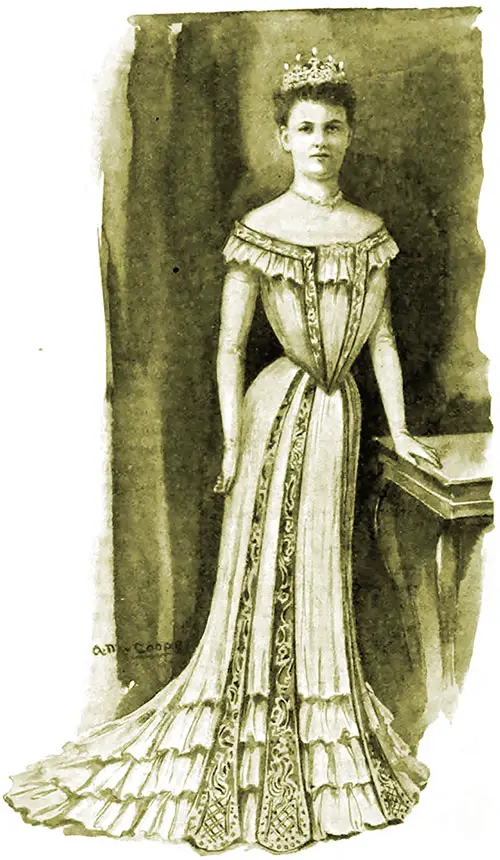
Yellow and White Gauze Ball Gown Over White Silk; Flounces Edged With Yellow Gauze Ribbon: Panels of Gold Galloon Embroidered With Pearls. GGA Image ID # 15f9d16e90
The bodice was décolleté and sleeveless. The drapery of tulle over the silver cloth rested in scant folds against the shoulders and back, but it fell in graceful fullness over the bust.
Almost all of the Queen's décolleté gowns have round necks, but this was slightly pointed in keeping with the deep point of the bodice at the waist. Embroidered orange blossoms sparkling with the brilliant gems in their composition covered the front and the wide revers on either side.
As the figure was turned around, the back presented that severity of outline and absence of fullness which is the fashionable Parisian back of the day. A multitude of folds were concealed at the waist to come out in the ample train.
Queen Wilhelmina's bridal cape was a vision of loveliness. It was silver cloth lined with white satin and an overlining of soft puffs of white chiffon. It was cut in one piece with a high Medicis collar and came halfway to the knees. A big bow of tulle, exactly like the wedding veil, was tied at the throat, with long ends reaching to the bottom.
The Queen Mother's wedding day gown was as carefully planned by Wilhelmina as her own, and it was made in Paris with the trousseau. It was of white satin and velvet of a deep violet shade.
On the skirt, the velvet formed a side drapery caught up twice by two large plumes in purple. The satin foundation thus disclosed showed a bold embroidery design of clusters of violets developed with purple panne velvet appliqué and silver. The train fell from the waist without a perceptible plait, but its marvelous cut gave it a wide sweep.
It was two and a half yards long and lined with white satin. The velvet bodice was pointed at the waist, but its front of white satin fell from the shoulders in a round line. Tiny bouquets of violets formed of velvet and silver on white satin decorated the rolling revers.
Few people were to see this gown, however, for Queen Emma had a beautiful cape of purple velvet to match it which she kept on nearly all the time. It was made with a yoke in front of white satin which came sharply from the shoulders to a long point at the bottom.
The yoke was outlined with a narrow row of purple ostrich tips, and it was closely embroidered with the design in violets of the gown. The cape was very wide, with deep plaits from the middle of the back to the yoke in front, and large scallops emphasized the pointed effect at the bottom in the velvet on either side.
The collar was low—for Queen Emma is stout and does not boast of a swanlike neck. It was trimmed with a feather edging and lined with white satin and violet chiffon, like the body of the cape.
The Queen Mother had to match it a small toque of purple velvet and violets, although for the ceremony itself she wore a long point-lace veil.
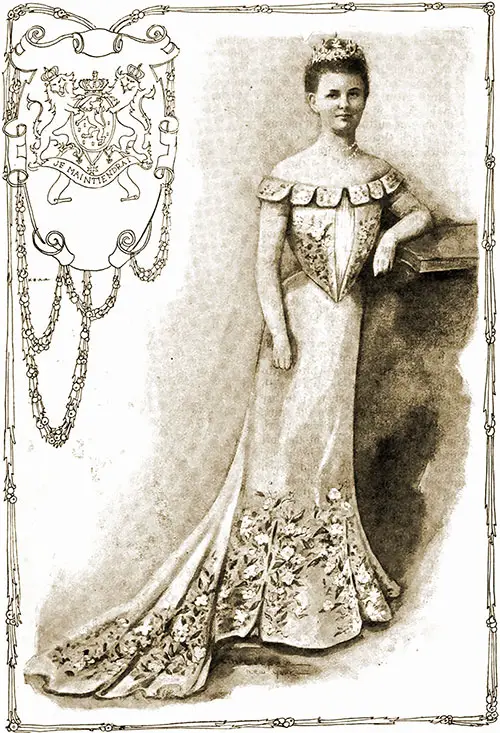
The Queen's White Satin Ball Gown With Embroidery of Apple Blossoms; Skirt Cut in Slashes, and Mousseline de Soie Showing Below. GGA Image ID # 15f9dbf9ae
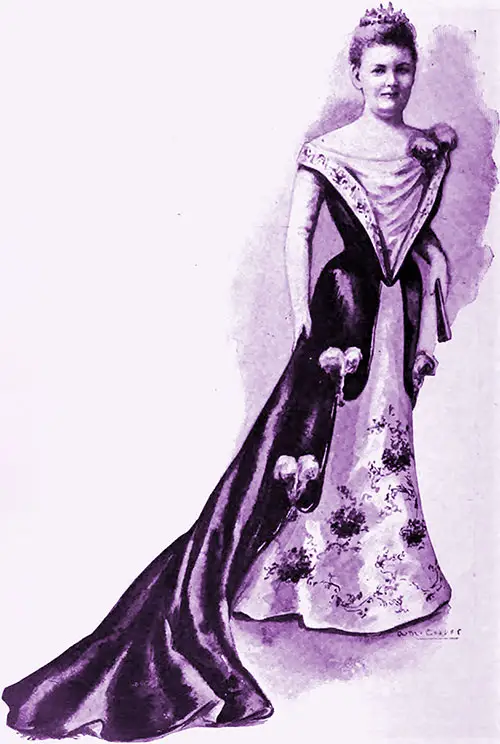
Dowager Queen Emma's Gown for the Wedding; White Satin and Deep Violet Velvet, Embroidered on Satin With Bunches of Violets and Silver. GGA Image ID # 15f9fbb8d4
When Queen Wilhelmina opens the great ball to mark her royal entrance into Amsterdam, in March, she will wear a white satin gown brocaded in leaves and trimmed with the real Alençon lace which belonged to her mother and is a royal treasure.
On the skirt, the lace is twenty inches wide and forms two flounces around the bottom which, at the left side in front, are caught up in a high bow with a branch of lilies. The broad green leaves, white petals, and yellow stamens are of velvet and show consummate skill in the milliner's art.
Most becoming to the young Queen are the lines of the drapery. The skirt is close-fitting around the top, while the beautiful lace is put on with enough fullness to make the lower part stand out well, increasing the look of slenderness above.
A flounce of white tulle under the bottom flounce of lace holds this out prettily, being pleated very full and doubled under to look thick. It runs around the skirt and peeps out as the drapery goes up into a knot with the flowers.'
The bodice has the blouse effect in front developed in spangled silver tulle with a bolero of brocade edged with a narrow ruffle of the Alençon lace. Lace and brocade make a butterfly bow at the top of the corsage, and there are fastened the stems of the lilies, whose leaves and flowers fall over the left shoulder. The back of the bodice and that of the skirt were made perfectly plain.
Among the other numerous evening gowns in the trousseau, Queen Wilhelmina has especially approved of two. One in white satin has a knee flounce so heavily embroidered in apple blossoms as to conceal almost the white satin beneath.
The skirt opens in three places at the bottom to show gored panels of white mull which reach from the top of the flounce to the hem. The flounce was cunningly fashioned to become a part of the train where the embroidery was heavier even than in front.
The bodice was of the embroidered satin with a few folds in front of white tulle. The round neck of the décolleté was decorated with embroidered satin scallops. The bodice was sleeveless like almost all of the evening gowns in the trousseau.
The other one of yellow and white gauze was made over white silk. Four wide flounces at the bottom were edged with a narrow yellow ribbon of gauze, and from the waist four panels of gold galloon, laid over with embroidery of white pearls, graduated to a width of seven inches at the hem.
The bodice showed the same effect with the embroidered gold galloon running on either side from waist to shoulder, and there being turned to edge the décolleté. A flounce of yellow and white gauze also trimmed the neck, laid under the galloon.
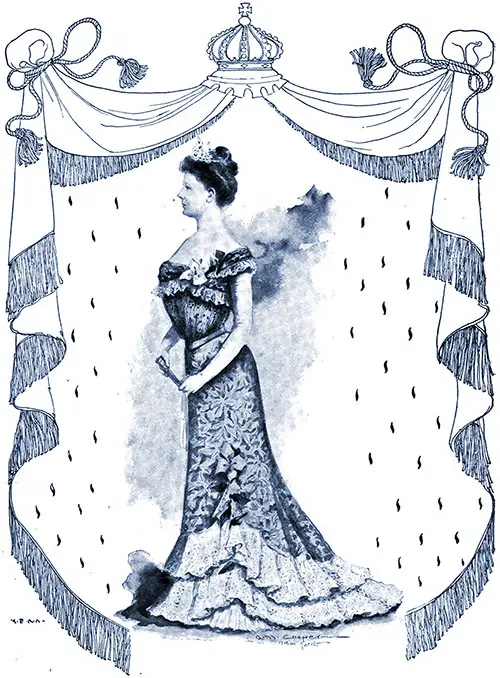
Queen Wilhelmina's Gown for the Great Ball at Amsterdam This Month; White Satin Embroidered With Leaves, and Trimmed With Real Alencon Lace. GGA Image ID # 15fa403daa
Another gown which will attract much attention is of mauve silk and trimmed with the beautiful Holland lace which was woven especially for it. The pattern is never to be duplicated, although an American millionaire has already offered a small fortune for a few yards of it to be given to his daughter, the wife of an English nobleman.
A splendid coat which will probably be worn for the public drive through Amsterdam is of soft green cloth with a wide collar of sable. It covers the gown entirely, fitting close to the figure and sweeping in ample folds on the ground. A short bolero of darker green has a fantastic decoration of gold galloon, and the coat is fastened with one big gold button at the side.
The Queen is fond of riding, as every one knows, and although she has never cared for hunting, she expects to go in for it now, since her husband is such a keen sportsman. Among her tailored dresses is a hunting gown of green, cut with the utmost severity. Another one of gray is so dark as to look almost black and is said to be especially becoming, for it diminishes the effect of her weight—she is already taking on the stoutness of her family.
Other gowns there are for riding, driving, dining, for every possible occasion in the honeymoon of a royal bride. Even more dear to the feminine heart, there are numerous soft and clinging negligees which are never seen except by intimates, who see a woman thus at her loveliest and best.
Then, each state gown has its own set of undergarments as exquisite and as carefully made as the gown itself. On her bridal day, the Queen was robed in soft white silk embroidered in white, and the petticoat for the wedding gown was of white taffeta accordion plaited in the flounce which had many insertions of dainty Valenciennes lace.
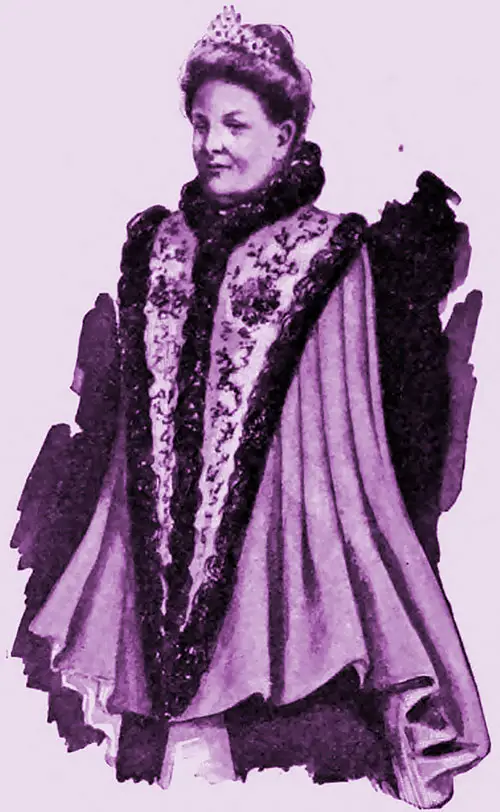
Queen Emma's Cape of Violet Velvet With White Satin Embroidered Yoke; Violet Chiffon Facing in Collar. GGA Image ID # 15fa556c10
Rebecca A. Insley, "Queen Wilhelmina's Trousseau," in Harper's Bazar, New York: Harper & Brothers, Vol. XXXIV, No. 11, 16 March 1901, pp. 705-710. Illustrated by A. M. Cooper from sketches sent from the Hague.

